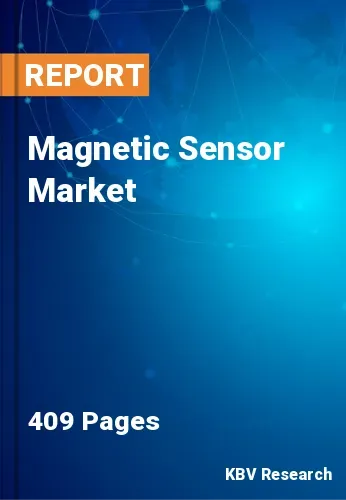The Global Magnetic Sensor Market size is expected to reach $5.9 billion by 2030, rising at a market growth of 5.8% CAGR during the forecast period. In the year 2022, the market attained a volume of 1,514.9 million Units experiencing a growth of 5.9% (2019-2022).
Magnetic sensors play a key role in position detection within the automotive system. Therefore, Automotive segment generated $1,549.2 million revenue in the market in 2022. As a result, magnetic sensors are employed for rotational angle measurement in applications where rotational movement needs to be monitored. This is especially critical in applications such as the steering system, where magnetic sensors assist in determining the steering wheel's position. These aspects will drive the demand for magnetic sensors in the future.
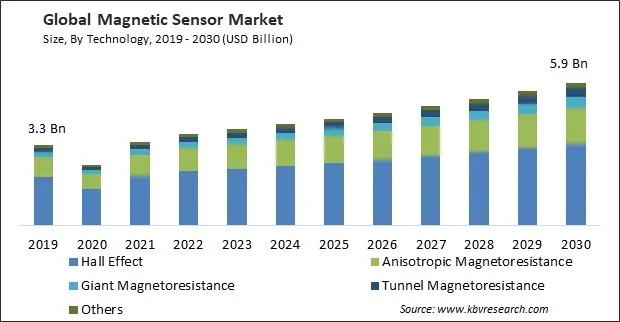
The major strategies followed by the market participants are Product Launches as the key developmental strategy to keep pace with the changing demands of end users. For instance, In October, 2023, TDK Corporation unveiled the HAL 3927 sensor, a linear, ratiometric analog output. The launched product would be designed for automotive and industrial applications. Moreover, In July, 2023, MultiDimension Technology Co., Ltd. announced the launch of several TMR switch sensors, including dual-axis quadrature-waveform TMR1222/TMR1228 bipolar switches. The launched product would be used for automotive level-sensing applications.
Based on the Analysis presented in the KBV Cardinal matrix; Honeywell International, Inc. is the major forerunner in the Market. In January, 2021, Honeywell International, Inc. released LIB Optical Caliper Sensor, an Optical Caliper Measurement Sensor. The launched product would offer an effective solution for measuring the true thickness of electrode material during coating and also at the pressing station during LIB manufacturing. Companies such as Infineon Technologies AG, Robert Bosch GmbH, and NXP Semiconductors N.V. are some of the key innovators in the Market.
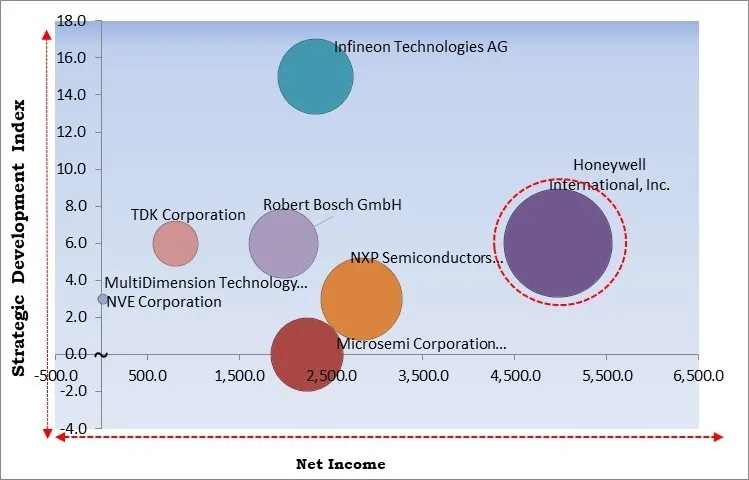
Magnetic sensors are extensively used for position sensing in industrial machinery and equipment. Whether it's monitoring the position of a robotic arm, detecting the location of a conveyor belt, or ensuring the proper alignment of components in a manufacturing line, magnetic sensors provide precise and reliable information. This accuracy is crucial for maintaining the desired workflow and correctly positioning each component. Monitoring rotational speed and linear velocity is a fundamental aspect of industrial automation. This information is essential for maintaining optimal operational speeds, preventing malfunctions, and facilitating efficient production processes. Thus, these factors will propel the expansion of the market in the coming years.
Magnetic sensors are integral to smartphones, contributing to several essential features. One of the primary applications is in the implementation of electronic compasses. These sensors, often based on magnetometer technology, enable smartphones to determine their orientation relative to the Earth's magnetic field. This functionality is crucial for navigation applications like map and GPS services. Gesture recognition enhances user interfaces, allowing users to interact with devices through gestures without physical touch, which is particularly relevant in smartphones and other smart devices. These factors are expected to help in the expansion of the market.
The sensors may be influenced or saturated in environments with strong external magnetic fields, leading to inaccurate readings. This is particularly relevant in industries where large magnets or magnetic materials are used. Calibration and positioning strategies are often employed to mitigate the impact of external magnetic fields, but extreme conditions can pose challenges. Mechanical stress and vibrations in certain environments, such as those encountered in heavy machinery or automotive applications, can impact the physical integrity of magnetic sensors. The alignment and positioning of sensor components may be affected, leading to deviations in sensor output. Design considerations for ruggedness and resilience become crucial in such applications. These aspects can hamper the growth of the market in the future.
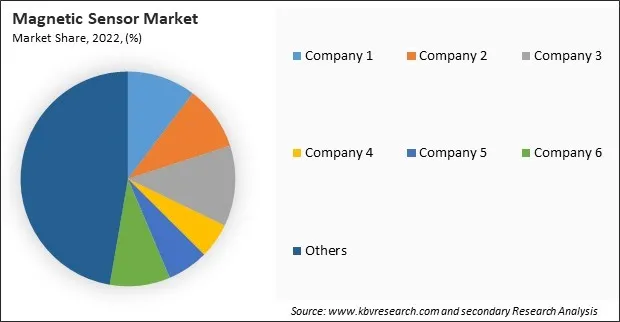
The leading players in the market are competing with diverse innovative offerings to remain competitive in the market. The above illustration shows the percentage of revenue shared by some of the leading companies in the market. The leading players of the market are adopting various strategies in order to cater demand coming from the different industries. The key developmental strategies in the market are Product Launches and Product Expansions.
Based on end-use, the market is divided into automotive, consumer electronics, industrial, and others. The automotive segment recorded the maximum revenue share in the market in 2022. One of the primary factors contributing to the growth of magnetic sensors in the automotive sector is the ongoing trend toward vehicle electrification. Electric vehicles (EVs) and hybrid vehicles utilize magnetic sensors for various applications, including motor control, battery management, and position sensing. Magnetic sensors play a crucial role in accurately determining the position of components such as the rotor in electric motors, ensuring optimal performance and efficiency. Owing to these factors, the segment will expand rapidly in the coming years.
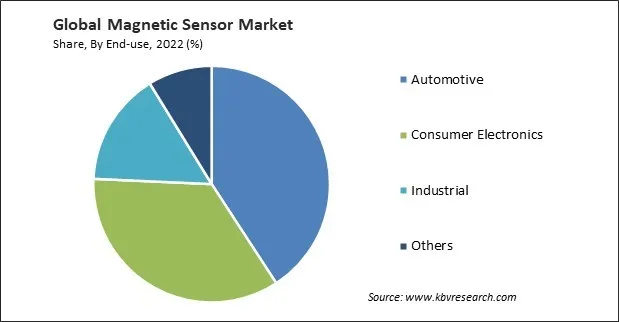
On the basis of technology, the market is divided into hall effect, anisotropic magnetoresistance, giant magnetoresistance, tunnel magnetoresistance, and others. In 2022, the anisotropic magnetoresistance segment witnessed a substantial revenue share in the market. Anisotropic magnetoresistance (AMR) sensors are known for their high sensitivity to magnetic fields. This attribute makes them particularly suitable for applications where precise and accurate measurements of magnetic changes are essential. The ability to detect subtle variations in magnetic fields enhances the performance of AMR sensors in diverse applications. Therefore, there will be increased growth in the segment.
On the basis of application, the market is segmented into position sensing, speed sensing, detection/NDT, navigation & electronic compass, and others. The position sensing segment procured the largest revenue share in the market in 2022. Magnetic sensors offer high precision and accuracy in measuring position, making them crucial in applications where exact positioning is essential, such as in robotics, automotive systems, and industrial automation. Similarly, in wind turbines, solar panels, and other renewable energy systems, magnetic sensors are used for position sensing to optimize the performance and efficiency of these systems. As new technologies emerge, such as autonomous vehicles, drones, and smart infrastructure, there's an increased demand for accurate and reliable position sensing, further driving the need for advanced magnetic sensor applications.
| Report Attribute | Details |
|---|---|
| Market size value in 2022 | USD 3.8 Billion |
| Market size forecast in 2030 | USD 5.9 Billion |
| Base Year | 2022 |
| Historical Period | 2019 to 2021 |
| Forecast Period | 2023 to 2030 |
| Revenue Growth Rate | CAGR of 5.8% from 2023 to 2030 |
| Number of Pages | 409 |
| Number of Table | 793 |
| Quantitative Data | Volume in Million Units, Revenue in USD Billion, and CAGR from 2019 to 2030 |
| Report coverage | Market Trends, Revenue Estimation and Forecast, Segmentation Analysis, Regional and Country Breakdown, Competitive Landscape, Market Share Analysis, Porter’s 5 Forces Analysis, Company Profiling, Companies Strategic Developments, SWOT Analysis, Winning Imperatives |
| Segments covered | End-use, Technology, Application, Region |
| Country scope |
|
| Companies Included | Honeywell International, Inc., Microsemi Corporation (Microchip Technology), NVE Corporation, NXP Semiconductors N.V., Robert Bosch GmbH, TDK Corporation, MEMSIC Semiconductor Co., Ltd. (IDG Capital Investment Consultant Beijing Co Ltd.), Infineon Technologies AG, Magnetic Sensors Corporation and MultiDimension Technology Co., Ltd. |
| Growth Drivers |
|
| Restraints |
|
By region, the market is segmented into North America, Europe, Asia Pacific, and LAMEA. In 2022, the Asia Pacific segment acquired the highest revenue share in the market. The Asia Pacific region has been a hub for rapid industrialization, with countries like China, India, and South Korea experiencing significant economic growth. This industrial expansion has increased demand for automation and control systems, where magnetic sensors are crucial. The APAC region's manufacturing, automotive, and electronics industries extensively utilize magnetic sensors for applications like position sensing, speed detection, and control systems. As a result, the segment will grow rapidly in the coming years.
Free Valuable Insights: Global Magnetic Sensor Market size to reach USD 5.9 Billion by 2030
The market research report covers the analysis of key stake holders of the market. Key companies profiled in the report include Honeywell International, Inc., Microsemi Corporation (Microchip Technology), NVE Corporation, NXP Semiconductors N.V., Robert Bosch GmbH, TDK Corporation, MEMSIC Semiconductor Co., Ltd. (IDG Capital Investment Consultant Beijing Co Ltd.), Infineon Technologies AG, Magnetic Sensors Corporation and MultiDimension Technology Co., Ltd.
By End-use (Volume, Million Units, USD Billion/Million, 2019-2030)
By Technology (Volume, Million Units, USD Billion/Million, 2019-2030)
By Application (Volume, Million Units, USD Billion/Million, 2019-2030)
By Geography (Volume, Million Units, USD Billion/Million, 2019-2030)


This Market size is expected to reach $5.9 billion by 2030.
Growing automation in various industries are driving the Market in coming years, however, Limited precision in extreme conditions concerns restraints the growth of the Market.
Honeywell International, Inc., Microsemi Corporation (Microchip Technology), NVE Corporation, NXP Semiconductors N.V., Robert Bosch GmbH, TDK Corporation, MEMSIC Semiconductor Co., Ltd. (IDG Capital Investment Consultant Beijing Co Ltd.), Infineon Technologies AG, Magnetic Sensors Corporation and MultiDimension Technology Co., Ltd.
In the year 2022, the market attained a volume of 1,514.9 million Units experiencing a growth of 5.9% (2019-2022).
The Hall Effect segment is generating the highest revenue in the Market by Technology in 2022;there by, achieving a market value of $3.4 billion by 2030.
The Asia Pacific region dominated the Market by Region in 2022, and would continue to be a dominant market till 2030;there by, achieving a market value of $2.3 billion by 2030.
Our team of dedicated experts can provide you with attractive expansion opportunities for your business.
